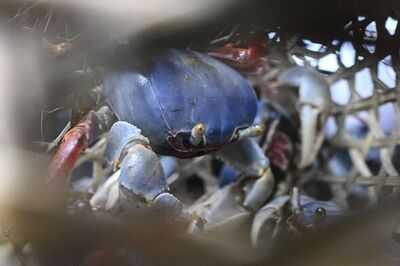A crab species, originally from the coasts of North and South America, has been found on the other side of the Atlantic on the island of Fuerteventura. The invasive species was encountered in Puertito de los Molinos, a small fishing village on the western coast of the second-largest Canary Island.
Though the species has been sighted in the archipelago before, cases remain rare and environmental experts have shared their concerns. This blue crab (Callinectes sapidus), is considered dangerous to native marine life. Adult specimens feed on fish, molluscs, crabs, prawns, cephalopods and even plants, making them a serious threat to local ecosystems. Experts have warned that this species - which is highly adaptable - can survive and spread quickly in through environments.
The crab is now being monitored by the Red de Detección Temprana de Especies Exóticas (Early Detection Network for Exotic Species), the official body responsible for locating, identifying, analysing, controlling and, where necessary, eradicating invasive species in the Canary Islands.
In recent years, the popular Spanish holiday archipelago has been plagued by sightings of potentially dangerous and invasive species. These include wildlife like lionfish, pufferfish and some species of jellyfish, all of which can pose risks to marine ecosystems and humans.
In some coastal areas, sightings of lionfish, known for their venomous spines, have led to increased monitoring by environmental agencies. Meanwhile, jellyfish blooms have led to temporary beach closures.

Earlier this year, a yellow flag was raised at Las Teresitas Beach in Santa Cruz de Tenerife after several Portuguese Man O' War were discovered on the shore. A Portuguese Man O' War (Physalia physalis) sting can cause intense pain, muscle spasms and, in extreme cases, neurological and cardiac complications. A special purple flag for marine fauna was also flown, alerting beachgoers to the potential danger.
Although commonly referred to as a jellyfish by the public, it is actually a siphonophore - a floating colony of polyps that work together and move, driven by wind and ocean currents.
"The Portuguese Man o' War is not native to the Mediterranean but to the Atlantic Ocean, where it inhabits tropical waters. However, under certain climatic conditions, it can be carried through the Strait of Gibraltar and reach Mediterranean coasts," explained sources from the Aula del Mar Mediterráneo foundation.
You may also like

The Simpler I Keep It, The Better I Will Perform: Shafali Looks Forward To Australia Challenge In WC Semifinal

Gujarati film 'Vash Level 2' sets record — made for ₹8 crore, earns over ₹16 crore and bags ₹3.5 crore OTT deal with Netflix

Even without 10000 steps a day, young woman loses 27 kg in six months. She shares her diet and post-meal routine

Cloud-seeding in Delhi scheduled for today put on hold

Footballer, 38, dies in freak accident after falling into shop window






